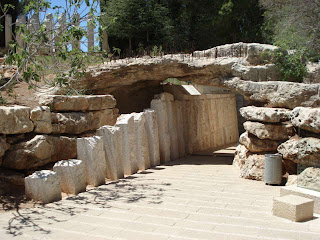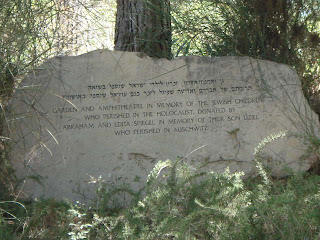They came first for the Communists,
and I didn't speak up because I wasn't a Communist.
Then they came for the trade unionists,
and I didn't speak up because I wasn't a trade unionist.
Then they came for the Jews,
and I didn't speak up because I wasn't a Jew.
Then they came for me,
and by that time no one was left to speak up.
-Martin Niemöller
This was one of the many quotes I saw they day we visited Yad Veshem, the Holocaust Memorial. For some reason, it's the one that stuck in my mind. Niemöller was a Lutheran minister who was sent to a concentration camp for speaking out against the German state. He wrote the poem years later because he felt the church didn't do enough to help the Jews during the Holocaust.
Established in 1953, Yad Veshem is the official memorial to Jewish victims of the Holocaust. The museum sits on a 45 acre complex outside Jerusalem. The site is vast, covering the entire Jewish experience during the Holocaust. It is the second most visited site in Israel after the Western Wall.
The main focal point is the Museum. It is comprised of 10 exhibit halls that tell the story of the Holocaust. The Museum uses not only photographs,but multi-media displays and short movies to tell the story. I learned quite a bit from the visit. At the beginning of the war, much of European Jewry was anxious to leave, but the rest of the world closed their doors to Jewish immigration. There is a quote from Prime Minister of Australia at the time who said, "We don't have an ethnic problem here, and we don't want one."
The pictures dealing with the executions were the hardest to look at. I am still struck by one photo of a group of Polish Jews who were being lined up by a firing squad and the man closet to the camera is staring at it and crying, well aware of his fate. A very haunting imagine to say the least.
I was surprised to learn that after the war, British controlled Palestine refused to let Jews immigrate legally to the area. Of course they came here anyway and in 1948 the State of Israel was founded.
In addition to the Museum, there is the Hall of Remembrance. It's a large dark room with an eternal flame. On the ground are the names of all the concentration camps. We learned that after the war, Israeli authorities visited the camps and gathered up all the ashes that were still in the crematoriums and buried them beneath the building. Of course there is no way of knowing who those people were, but their final resting place is in Israel.
The hardest part of the visit for me was the Children's Memorial. A separate exhibit, it was funded by the Spiegel family (think catalog) in honor of their son Uziel who was killed at Auschwitz. As you walk into the dark room, there are several candles. Thru the use of mirrors, their image is duplicated and duplicated so that the entire room looks like a sky full of stars (a reference to God's promise to Abraham that his descendants will equal the number of stars in the sky). The names of all 1.5 million children killed in the Holocaust are played on a continuous loop with their name, age, and country. Everyone walks out of that exhibit with moist eyes.
Beyond the Children's Memorial is a statue of an unknown "Righteous Man" (the Righteous are the non-Jews who tried to help and protect Jews during the war). The story goes that after a group of young boys were left orphaned in the ghetto in Krakow, he moved into the slums to be their teacher and take care of them. When they were moved to the concentration camps, he went along, and when they were sent to the gas chambers, he refused to leave them, sacrificing his life to be with them til the end.
The Garden of the Righteous honors those non-Jews known to have helped during the war. Each has a tree planted in their memory. Oskar and Emily Schindler are there. (Oskar Schindler is actually buried at the Catholic Cemetery in Jerusalem).
Though it was an emotionally exhausting day, the visit to Yad Veshem was an important part of the trip.










No comments:
Post a Comment